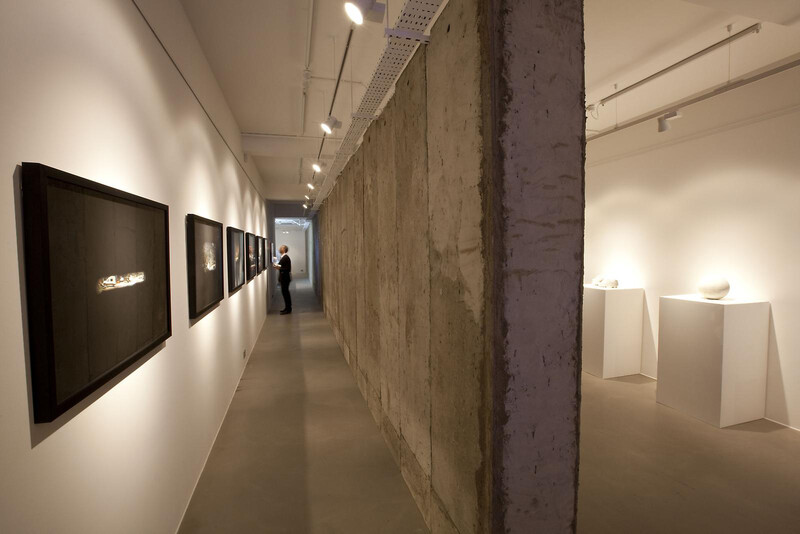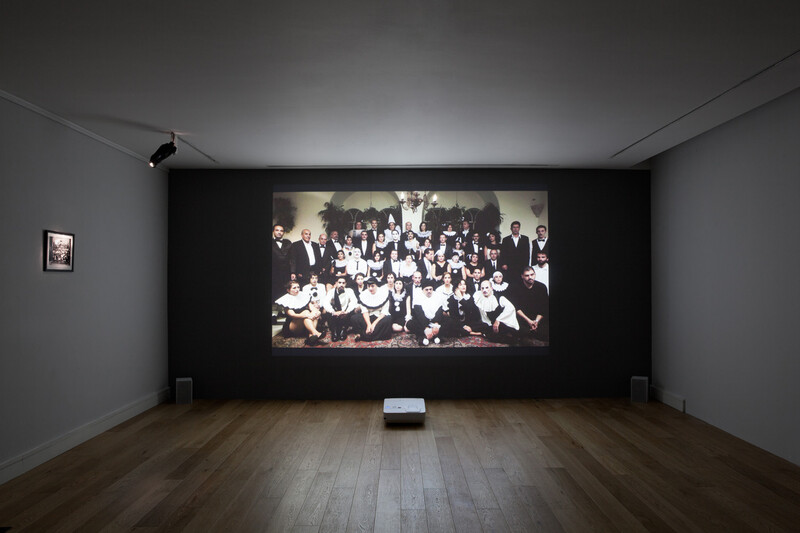The Electronic Intifada London 15 July 2013

Khaled Jarrar’s Whole in the Wall installation in London (Image courtesy of Ayyam Gallery)
The freshness and ingenuity of young Palestinian artists’ work shines through in two new exhibitions in London.
Whole in the Wall at Ayyam Gallery is the latest offering by Khaled Jarrar, exemplifying his signature interest in Israel’s wall in the occupied West Bank and his irreverent and yet entirely serious approach to it.
Entering the gallery, you are confronted by an eight-foot-high replica of the wall. It stretches away to your left, forming a narrow corridor, funneling the viewer towards the bulk of the exhibition. This includes a selection of sports objects — footballs and a basketball, soccer boots, table-tennis bats and ball and a discus — all cast from concrete patiently (and riskily) chipped from the wall itself. The lightness and mobility of sport contrasts with the dead weight of the actual objects, which can barely be lifted.
The theme continues with a split-screen video of Jarrar and British artist Jeremy Hutchison playing squash over the wall. The different conditions on each side are brought into sharp focus by the simultaneity of the films; on the Palestinian side, the ground is rough, the wall bare and ugly, with graffiti scrawled on it. On the Israeli side, the road is newly metalled and tidy, and the wall itself — in an act of bizarre denial — has been attractively painted. Only the blue sky above is shared.
Supreme irony
The strangest item in the show is, though, a concrete “Buddy Bear,” a motif which will be most familiar to Berliners. The cuddly figures originated as a celebration of peace and international understanding after German reunification; casting from the dust of the 21st century’s great “Wall” a creature symbolizing the fall of the wall which divided the 20th is a supreme irony.
The show’s title comes from a series of photos taken through a small gap in the wall, showing “normal” life on the other side, and emphasizing the separation of people and the incomprehension it exacerbates.
Meanwhile, another image shows a tree which has forced its shoots between two sections of the wall; on one hand, it is a force of nature which defies the strength of this deeply unnatural creation. On the other, the fact that its main trunk has been broken off underscores the ongoing destructiveness of the occupation.
A similar sense of the intrinsic artificiality and wrongness of the wall and its accompanying paraphernalia comes from the final works,”Olive Tree Stump” and “Olive Tree Branch.” In both, Jarrar has split a piece of olive wood — replete with symbolism of Palestinian home and country — and replaced one half with an exact cast, again in concrete from the wall.
Stolen symbols
The Israeli army and settlers routinely destroy olive groves, appropriate and replant olive trees in an attempt to “root” settlements, and bulldoze trees to build the wall itself. These “sculptures” reflect the way in which the State of Israel has tried to replace Palestinian culture and society with a simulacrum, deeply and damagingly unsure of itself and reliant on stolen symbols.
To exit the exhibition, you have two choices. To retrace your steps, or to clamber ungracefully out of a Palestine-shaped hole in the wall. It’s a nice touch.

Mirna Bamieh’s “This Mined Land of Ours” (Image courtesy of The Mosaic Rooms)
The Mosaic Rooms, meanwhile, are displaying works by the winners and runners-up of the AM Qattan Foundation’s Young Artist of the Year Award, which was shown in Ramallah late last year.
Two of the six are directly related to Israel’s occupation of the Golan Heights. In Mirna Bamieh’s “This Mined Land of Ours,” a soundtrack taken from the mobile phones of people who walked across the boundary between the Israeli-occupied area and Syria on Nakba Day 2011 accompanies video of the columns of protestors.
But the background is entirely whited out, so that they process across a clear white space.
“I abstract this land that is physically, mentally and politically mined,” Bamieh states in a note accompanying the work. “I abstract this land to purify it from history. I abstract this land to open it up.”
Poignant
“Promises” by Shada Safadi from the village of Majdal Shams in the occupied Golan is the most haunting work in the exhibition. Life-sized human images are painted onto clear plastic, as if bodies had been laid on the surface. Light beamed onto these means that the ghostly white shapes also cast shadows on the wall beyond.
The effect is eerie but beautiful, and even more poignant when one notices that some of the images are children. “We forget the promises we give to our dead,” Safadi writes.
In an engagement with the wider Arab uprisings, Majd Abdel Hamid’s work “Muhammad Bouazizi” references both pop art and Palestinian popular craft skills. A series of images of the Tunisian martyr are neatly embroidered in cross-stitch by women from the village of Farkha, each selecting their own bright color scheme.
Political edge

Jumana Manna’s “A Sketch of Manners” (Image courtesy of The Mosaic Rooms)
Omar Khoury’s “The PLO Clogs” and “The President’s Panel” also refer to traditional craft styles, but with a deeply cynical, political edge. The latter adopts the design of the square embroidered panels on the front of old-fashioned Palestinian dresses, but employs macho, militaristic motifs — grenades, helicopters and swords — and places them alongside excerpts of speeches by Yasser Arafat and Mahmoud Abbas.
“The PLO Clogs,” also displayed in a mock-museum style like a historical artifact, imitates a pair of Ottoman-era upper-class shoes, with designs appropriating the Palestine Liberation Organization logo and motto. In placing these emblems of the national struggle on an antiquated fashion item, Khoury observes that “slogans have become simultaneously sacred and vapid.”
The first prize winner Jumana Manna’s short film “A Sketch of Manners” recreates “the last masquerade in Palestine,” a fancy-dress party held by a Palestinian politician and landowner in 1942. Filmed in the sumptuous surroundings of Jerusalem’s American Colony Hotel, society beauties and bucks in Pierrot makeup evoke a sense of a brittle, doomed era of glamor, to a soundtrack of Baudelaire’s decadent poetry. One can’t but read it as a metaphor for the aid-fueled nightlife of the modern “Ramallah bubble.”
Whole in the Wall is on display at the Ayyam Gallery, London, until 3 August.
The Young Artist of the Year Award exhibition is on display at the Mosaic Rooms, London, until 16 August.
Sarah Irving is a freelance writer. She worked with the International Solidarity Movement in the occupied West Bank in 2001-02 and with Olive Co-op, promoting fair trade Palestinian products and solidarity visits, in 2004-06. She is the author of a biography of Leila Khaled and of the Bradt Guide to Palestine and co-author, with Sharyn Lock, of Gaza: Beneath the Bombs.





